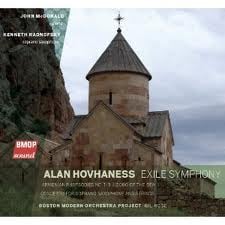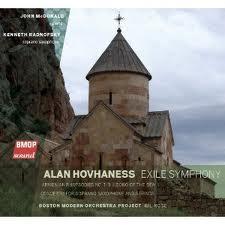
In this Boston Modern Orchestra Project release, several earlier works of Alan Hovhaness (1911–2000), mixed with a fairly lame later one, provide insights into the origin of the composer’s distinctive style, as well as pleasant listening.
Hovhaness, who is celebrated today, even stereotyped, as an Armenian-American composer, was in fact a highly multicultural individualist, with the music of Armenia forming only one of many influences. This CD reminds me that his mother was of Scottish descent, given the inclusion of his 1933 Song of the Sea for piano and string orchestra, with its British Isles–sounding melodies.
During World War II, Hovhaness reinvestigated the Armenian heritage of his father, and wrote his Armenian Rhapsodies 1, 2, and 3. These last 5 to 8 minutes each and are unobtrusively formulaic. Melismatic, near-Eastern-sounding melodies wind over string drones to start. After a while, imitative counterpoint sets in and then subsides. From time to time, pizzicato strings accompany the relatively directionless goings-on. Hovhaness was one of last century’s champion composers in terms of output — 67 symphonies, close to 500 opus numbers. This was because, as he reported in a very interesting interview included in the CD’s booklet notes, “Ideas persecute me if I don’t write. I have ideas every day of my life.” And many of them can be very much the same, as demonstrated by these rhapsodies.
The Concerto for Soprano Saxophone, the sole work on this release from Hovhaness’ latter decades, shows more variety than the Rhapsodies. But, as with the piano in Song of the Sea, it is anathema to a big-egoed soloist. No virtuosity is employed, nor does the soloist do any more work than the rest of the orchestra. Indeed, the saxophone contributes to less than half of the finale, introducing and reprising a beautiful melody accompanied by pizzicato strings right out of the humming chorus of Madame Butterfly.
It’s the composer’s 1936 Symphony No. 1, the “Exile,” that is the main reason for considering this release. It is the one item that, unless you’re a Hovhaness fanatic, you may want to hear more than a couple of times. It should have been placed in the first tracks instead of the last. This work illustrates both Hovhaness’ most attractive characteristics and his influences, and was penned nearly 20 years before he began the binge of his next 66 symphonies with his most famous one, the No. 2, “Mysterious Mountain.”
The “Exile” begins with the Puccini-like pizzicato figures, then interjects three stirring brass-fanfare passages, before horns and timpani recall Sibelius. Suddenly, at three and a half minutes, Mendelssohn of Midsummer Night’s Dream appears. Sudden bursts of rapid notes, transformed from their Mendelssohnian beginnings by the more experienced Hovhaness, become a fixture of many of his later works.
The short second movement begins with a lovely tune that Vaughan Williams or Holst would have easily added to one of their folk song suites, then moves to a hybrid Nordic tune with melismatic, Arabic tinges. The finale opens with two minutes of recollections from the previous movements, then strikes up a call to arms with galloping figures in the strings overlain by a Protestant hymnal–like chorale in the brass. The only real development in the movement is an eventual return of the “British” folk song tune in imitative counterpoint, which then moves to a concluding peroration of the chorale worthy of Sibelius’ Finlandia.
However derivative the music, the tunes are high quality. No passages overstay their welcome, and, unlike the rest of the release, which makes for fine, dreamy background listening, there’s some real drama in the music — not inappropriate for a piece whose subtitle calls attention to the plight of the people of the Armenian diaspora, who fled to avoid depredations by the Ottoman armies during World War I.
The recording quality, orchestral performances, and Gil Rose's conducting are all quite satisfactory.

